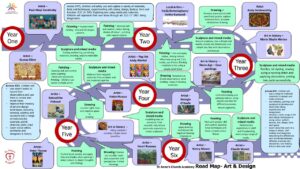Subjects -
Art/DT
‘Every human is an artist’
Don Miguel Ruiz
The road map below is to show the Art and DT curriculum as it progresses through the school from Reception to Year 6.
Art DT
ART
We believe that high-quality Art lessons will inspire children to think innovatively and develop creative understanding. Our Art curriculum provides children with opportunities to develop their skills using a range of media and materials. Following the National curriculum, children learn the skills of drawing, painting, printing, collage and sculpture and are given the opportunity to explore and evaluate different creative ideas. Children will be introduced to a range of works and develop an understanding of the styles and vocabulary used by famous artists including local artists. The skills they acquire are applied to their cross-curricular learning allowing children to use their art skills to reflect on and explore their learning in greater depth; for example, by sketching historical artefacts in detail or using art as a medium to express emotion and thought to enhance their personal, social and emotional development. It is paramount that art work be purposeful; be this as a means of expression or to explore the styles of other artists that inspire our own work.
In Art and design, children are expected to be reflective and evaluate their work, thinking about how they can make changes and keep improving. Children are encouraged to take risks and experiment and then reflect on why some ideas and techniques are successful or not for a particular project. Every child will leave St Anne’s an artist.
DT
Children will be taught key knowledge, skills and vocabulary through sequences of coherent and connected lessons. Design & technology will encourage children to creatively solve problems both as individuals and as members of a team. Children will design and make products that solve real and relevant problems within a variety of contexts, considering their own and others’ needs, wants and values.
In KS1 children will give children opportunities to design products that are relevant to them (such as the home and school, gardens and playgrounds, the local community, industry and the wider environment). In KS2 children will be taught to analyse and create their own innovative and functional products for a range of relevant contexts (for example, the home, school, leisure, culture, enterprise, industry and the wider environment)






